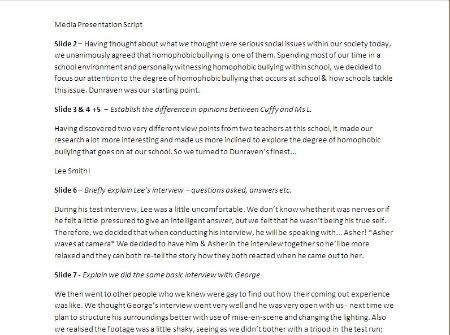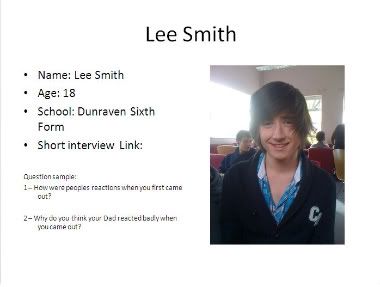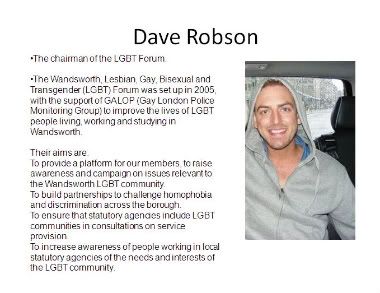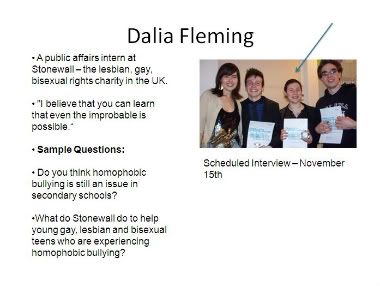Mia's Individual Blog
Friday, 18 February 2011
How effective is the combination of your main product and ancillary texts?
As our target audience was film/documentary enthusiasts as well as older people and teenagers; we thought the review would be most suitable for a magazine like Empire. We looked through issues of the magazine, focusing on it's visual style & how they write their reviews. When then tried to emulate these in our own review.



We included both a film synopsis & an end verdict - allowing the audience to gain a basic knowledge of what the documentary is about & providing a condensed opinion on it. It then gives them the option to read on in more detail.
We decided to use a bright, colourful screenshot from our film. The mise-en-scene within the shot is incredibly relatable to the teen audience, with posters of bands & a computer being visible. The bright image also diverts away from the dark subject matter.

The image of the two men holding hands instantly highlights that the film is about homosexuality. It dominates the page, showing the audience that it's the main focus of the documentary.
The juxtaposition of the grey scale image and the rainbow represent the conflicting views of gay people within everyday life. The happy, positive representations presented by the media, and the harsh reality of the way gay people are treated within schools. Similarly, the rainbow is a prominent form of LGBT iconography - which is used to represent the diversity within the LGBT community. This allows the subject matter within the documentary and what is being explored to be known to the audience. It also represents the narrative of the film, as it switches from a bleak tone to a cheerier tone throughout.
We went on YouTube & learnt how to create a rainbow effect as it was proving difficult to cut around a photograph of a rainbow.

The use of the "Inked God" typography gives an edgy tone to the poster, representing the dark, more gritty content within the documentary. Additionally, this coincides with the grey scale photograph which already creates a gloomy effect.



We included both a film synopsis & an end verdict - allowing the audience to gain a basic knowledge of what the documentary is about & providing a condensed opinion on it. It then gives them the option to read on in more detail.
We decided to use a bright, colourful screenshot from our film. The mise-en-scene within the shot is incredibly relatable to the teen audience, with posters of bands & a computer being visible. The bright image also diverts away from the dark subject matter.

The image of the two men holding hands instantly highlights that the film is about homosexuality. It dominates the page, showing the audience that it's the main focus of the documentary.
The juxtaposition of the grey scale image and the rainbow represent the conflicting views of gay people within everyday life. The happy, positive representations presented by the media, and the harsh reality of the way gay people are treated within schools. Similarly, the rainbow is a prominent form of LGBT iconography - which is used to represent the diversity within the LGBT community. This allows the subject matter within the documentary and what is being explored to be known to the audience. It also represents the narrative of the film, as it switches from a bleak tone to a cheerier tone throughout.
We went on YouTube & learnt how to create a rainbow effect as it was proving difficult to cut around a photograph of a rainbow.

The use of the "Inked God" typography gives an edgy tone to the poster, representing the dark, more gritty content within the documentary. Additionally, this coincides with the grey scale photograph which already creates a gloomy effect.
Monday, 14 February 2011
Thursday, 10 February 2011
Monday, 29 November 2010
Film Poster Mock-Up
Please click to enlarge (sorry for bad lighting!)
I thought a less is more approach would be best for the poster of our documentary, as it's genre doesn't require a bright, busy layout, which would give out the wrong message and impression to potential audiences.

For inspiration, I went to www.impawards.com - a site dedicated to almost every film poster. I searched through many different posters from different film genres, including Supersize Me, Requiem for a Dream & When You're Strange, but ultimately went with a poster that I thought gave an indication into what the film was about without giving too much away & keeping a less is more type of style. That poster was for Little Miss Sunshine.
This inspired the layout of my poster, especially the idea of having a strip of images of people featured in the documentary, accompanied by a photograph underneath to give some insight into what the film is about.
This inspired the layout of my poster, especially the idea of having a strip of images of people featured in the documentary, accompanied by a photograph underneath to give some insight into what the film is about.

For the photographic image, I drew inspiration from the
poster for Hard Candy, which has an image of a girl placed in the centre of the poster, looking quite small in the frame as well not facing the camera, perceiving her to be introverted. It also has connotations of loneliness and sadness, which is an apparent theme in our documentary.
I thought we could replicate this in our photograph for the poster, having a teenage boy or girl standing in front of a school building, but having them appear to be very small within the shot, with the school dominating it, giving intimidating and unwelcoming connotations. This represents the struggle some gay teenagers face with going to school as it isn't a welcoming, happy place; but a place of sadness and suffering. As our documentary explores homophobic bullying in schools, I thought this image would give an insight into what the whole documentary is about and intrigue people to see it.
I thought we could replicate this in our photograph for the poster, having a teenage boy or girl standing in front of a school building, but having them appear to be very small within the shot, with the school dominating it, giving intimidating and unwelcoming connotations. This represents the struggle some gay teenagers face with going to school as it isn't a welcoming, happy place; but a place of sadness and suffering. As our documentary explores homophobic bullying in schools, I thought this image would give an insight into what the whole documentary is about and intrigue people to see it.
As our audience is predominantly teenagers and adults (those who work in schools more so), the image of the building and the teenager is something they can easily relate to and potentially encourage them to watch the film as they can identify with the environment and experiences with the young person on the poster.
When creating this poster, the group hadn't decided on a working title for the film or a tagline. We've now decided on "The Other Side of the Rainbow" as our title, with the tagline "This certainly isn't a pot of gold". I don't think this poster reflects the title of our documentary, and therefore will not be used. The group decided to come together and make a mock-up together.
When creating this poster, the group hadn't decided on a working title for the film or a tagline. We've now decided on "The Other Side of the Rainbow" as our title, with the tagline "This certainly isn't a pot of gold". I don't think this poster reflects the title of our documentary, and therefore will not be used. The group decided to come together and make a mock-up together.
Wednesday, 24 November 2010
Sunday, 14 November 2010
Final Evaluation
Unfortunately, I was unable to participate in the my group's presentation due to illness. I did however contribute work leading up to the presentation.
I wrote half the script for the presentation (sample pictured below) summarising each slide and expanding on any points made on it.

I also created 3 slides for the Powerpoint presentation, including information about our interviewees.



I have planned the interviews with the three people above (Lee Smith, Dave Robson & Dalia Fleming) and have given them sample questions to prepare themselves for the interviews. Lee's sample questions are on his slide.
Dave's sample questions:
- What is your role at the LGBT forum? What kind of work do you do? What aspired you to get involved?
- Do you think homophobic bullying is still a serious issue within schools, and do you think schools are prioritising tackling the issue?
- Since working at the LGBT Forum, has homophobic bullying within schools been an issue that has been raised often?
- Do you or anyone else who works at the forum go into schools? If so, what do you do?
Dalia's sample questions:
- Do you think homophobic bullying is still an issue in secondary schools nowadays?
- Since working with Stonewall, have you met a lot of teenagers who have been victims or have witnessed homophobic bullying in school?
- What do Stonewall do to help victims of homophobic bullying?
- What can other people do to help prevent this from happening in schools?
I wrote half the script for the presentation (sample pictured below) summarising each slide and expanding on any points made on it.

I also created 3 slides for the Powerpoint presentation, including information about our interviewees.



I have planned the interviews with the three people above (Lee Smith, Dave Robson & Dalia Fleming) and have given them sample questions to prepare themselves for the interviews. Lee's sample questions are on his slide.
Dave's sample questions:
- What is your role at the LGBT forum? What kind of work do you do? What aspired you to get involved?
- Do you think homophobic bullying is still a serious issue within schools, and do you think schools are prioritising tackling the issue?
- Since working at the LGBT Forum, has homophobic bullying within schools been an issue that has been raised often?
- Do you or anyone else who works at the forum go into schools? If so, what do you do?
Dalia's sample questions:
- Do you think homophobic bullying is still an issue in secondary schools nowadays?
- Since working with Stonewall, have you met a lot of teenagers who have been victims or have witnessed homophobic bullying in school?
- What do Stonewall do to help victims of homophobic bullying?
- What can other people do to help prevent this from happening in schools?
Subscribe to:
Comments (Atom)
